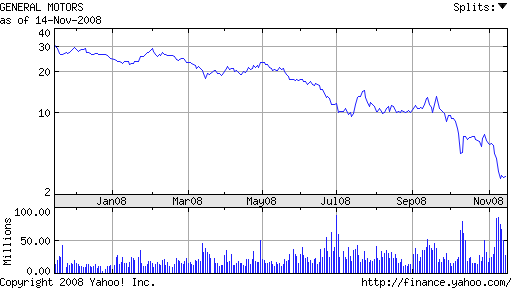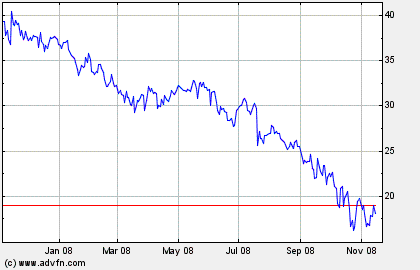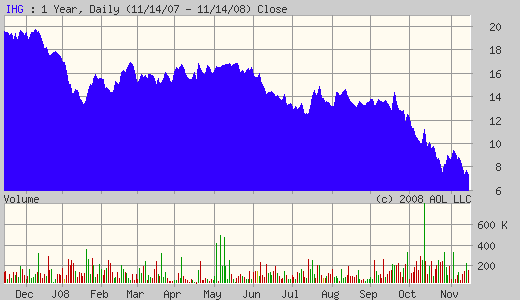The Great Depression of the 21st Century: Collapse of the Real Economy

The financial crisis is deepening, with the risk of seriously disrupting the system of international payments.
This crisis is far more serious than the Great Depression. All major sectors of the global economy are affected. Recent reports suggest that the system of Letters of Credit as well as international shipping, which constitute the lifeline of the international trading system, are potentially in jeopardy.
The proposed bank “bailout” under the so-called Troubled Asset Relief Program (TARP) is not a “solution” to the crisis but the “cause” of further collapse.
The “bailout” contributes to a further process of destabilization of the financial architecture. It transfers large amounts of public money, at taxpayers expense, into the hands of private financiers. It leads to a spiraling public debt and an unprecedented centralization of banking power. Moreover, the bailout money is used by the financial giants to secure corporate acquisitions both in the financial sector and the real economy.
In turn, this unprecedented concentration of financial power spearheads entire sectors of industry and the services economy into bankruptcy, leading to the layoff of tens of thousands of workers.
The upper spheres of Wall Street overshadow the real economy. The accumulation of large amounts of money wealth by a handful of Wall Street conglomerates and their associated hedge funds is reinvested in the acquisition of real assets.
Paper wealth is transformed into the ownership and control of real productive assets, including industry, services, natural resources, infrastructure, etc.
Collapse of Consumer Demand
The real economy is in crisis. The resulting increase in unemployment is conducive to a dramatic decline in consumer spending which in turn backlashes on the levels of production of goods and services.
Exacerbated by neoliberal macro-economic policy, this downward spiral is cumulative, ultimately leading to an oversupply of commodities.
Business enterprises cannot sell their products, because workers have been laid off. Consumers, namely working people, have been deprived of the purchasing power required to fuel economic growth. With their meager earnings, they cannot afford to acquire the goods produced.
Overproduction Triggers a String of Bankruptcies
Inventories of unsold goods pile up. Eventually, production collapses; the supply of commodities declines through the closing down of production facilities, including manufacturing assembly plants.
In the process of plant closure, more workers become unemployed. Thousands of bankrupt firms are driven off the economic landscape, leading to a slump in production.
Mass poverty and a Worldwide decline in living standards is the result of low wages and mass unemployment. It is the outcome of a preexisting global cheap labor economy, largely characterized by low wage assembly plants in Third World countries.
The current crisis extends the geographic contours of the cheap labor economy, leading to the impoverishment of large sectors of the population in the so-called developed countries (including the middle classes).
In the US, Canada and Western Europe, the entire industrial sector is potentially in jeopardy.
We are dealing with a long-term process of economic and financial restructuring. In its earlier phase, starting in the 1980s during the Reagan Thatcher era, local and regional level enterprises, family farms and small businesses were displaced and destroyed. In turn, the merger and acquisition boom of the 1990s led to the concurrent consolidation of large corporate entities both in the real economy as well as in banking and financial services.
In recent developments, however, the concentration of bank power has been at the expense of big business.
What is distinct in this particular phase of the crisis, is the ability of the financial giants (through their overriding control over credit) not only to create havoc in the production of goods and services, but also to undermine and destroy large corporate entities of the real economy.
Bankruptcies are occurring in all major sectors of activity: Manufacturing, telecoms, consumer retail outlets, shopping malls, airlines, hotels and tourism, not to mention real estate and the construction industry, victims of the subprime mortgage meltdown.
General Motors has confirmed that “it could run out of cash within a few months, which could prompt one of the biggest bankruptcy filings in U.S. history”. (USNews.com, November 11, 2008)) In turn this would backlash on a string of related industries. Estimates of job losses in the US auto industry range from 30,000 to as much as 100,000.(Ibid).

Collapse of General Motors Share Price
In the US, consumer retail companies are in difficulty: the share prices of JC Penney and Nordstrom department store chains have collapsed. Circuit City Stores Inc. filed for Chapter 11 protection. The shares of Best Buy, the electronics retail chain, have plunged.

The Vodafone Group PLC, the world’s biggest mobile phone company not to mention InterContinental Hotels PLC are in difficulty, following the collapse of stock values. (AP, Nov 12, 2008). Worldwide, over two dozen airlines have gone under in 2008, adding to a string of airline bankruptcies in the course of the last five years. (Aviation and Aerospace News, 30 October 2008). Denmark’s Second commercial airline Stirling has declared bankruptcy. In the US, a growing list of real estate companies have already filed for bankruptcy protection.

Vodophone. Collapse of Share Price

InterContinental Hotels PLC
In the last two months, there have been numerous plant closures across America leading to the permanent layoff of tens of thousands of workers. These closures have affected several key areas of economic activity including the pharmaceutical and chemical industries, the automobile industry and related sectors, the services economy, etc.
US factory orders have declined dramatically. Research firm Autodata reported in October that “sales of cars and light trucks in September had declined 27 percent compared with a year earlier.”(Washington Post, October 3, 2008)
Unemployment
According to the US Bureau of Labor Statistics, an additional 240,000 jobs were lost during the month of October alone:
“Nonfarm payroll employment fell by 240,000 in October, and the unemployment rate rose from 6.1 to 6.5 percent, the Bureau of Labor Statistics of the U.S. Department of Labor reported today. October’s drop in payroll employment followed declines of 127,000 in August and 284,000 in September, as revised. Employment has fallen by 1.2 million in the first 10 months of 2008; over half of the decrease has occurred in the past 3 months. In October, job losses continued in manufacturing, construction, and several service-providing industries…
Among the unemployed, the number of persons who lost their job and did not expect to be recalled to work rose by 615,000 to 4.4 million in October. Over the past 12 months, the size of this group has increased by 1.7 million.” (Bureau of Labor Statistics, November, 2008)
The official figures do not describe the seriousness of the crisis and its devastating impact on the labor market, since many of the job losses are not reported.
The situation in the European Union is equally disturbing. A recent British report points to the potential plight of mass unemployment in North Eastern England. In Germany, a report published in October, suggests that 10-15% of all automotive jobs in Germany could be lost.
Job cuts have also been announced at General Motors and Nissan-Renault plants in Spain. Sales of new cars in Spain plummeted by 40 percent in October in relation to sales in the same month last year.

Workers of Nissan automaker protest in front of the Japanese company’s building in Barcelona (AFP)
Bankruptcies and Foreclosures: A Money-spinning Operation for the Financial Giants
Among the companies on the verge of bankruptcy are some highly lucrative and profitable operations. The important question: who takes over the ownership of bankrupt giant industrial corporations?
Bankruptcies and foreclosures are a money-spinning operation. With the collapse in stock market values, listed companies experience a major collapse of the price of their stock, which immediately affects their creditworthiness and their ability to borrow and/ or to renegotiate debts ( which are based on the quoted value of their assets).
The institutional speculators, the hedge funds, et al have cashed in on their windfall loot.
They trigger the collapse of listed companies through short selling and other speculative operations. They then cash in on their large scale speculative gains.
According to a report in the Financial Times, there is evidence that the plunge of the US automobile industry was in part the result of manipulation: “General Motors and Ford lost 31 per cent to $3.01 and 10.9 per cent to $1.80 despite hopes that Washington may save the industry from the brink of collapse. The fall came after Deutsche Bank set a price target of zero on GM.” (FT, November 14, 2008, emphasis added)
The financiers are on a shopping-spree. America’s Forbes 400 billionaires are waiting in limbo.
Once they have consolidated their position in the banking industry, the financial giants including JP Morgan Chase, Bank of America, et al will use their windfall money gains and bailout money provided under TARP, to further extend their control over the real economy.
The next step consists in transforming liquid assets, namely money paper wealth, into the acquisition of real economy assets.
In this regard, Warren Buffett’s Berkshire Hathaway Inc. is a major shareholder of General Motors. More recently, following the collapse in stock values in October and November, Buffett boosted his stake in oil producer ConocoPhillips, not to mention Eaton Corp, whose price on the NYSE tumbled by 62% in relation to its December 2007 high (Bloomberg).
The target of these acquisitions are the numerous highly productive industrial and services sector companies, which are on the verge of bankruptcy and/or whose stock values have collapsed.
The money managers are picking up the pieces.
Ownership of the Real Economy
As a result of these developments, which are directly related to the financial meltdown, the entire ownership structure of real economy assets is in turmoil.
Paper wealth accumulated through insider trading and stock market manipulation is used to acquire control over real economic assets, displacing the preexisting ownership structures.
What we are dealing with is an unsavory relationship between the real economy and the financial sector. The financial conglomerates do not produce commodities. They essentially make money through the conduct of financial transactions. They use the proceeds of these transactions to take over bona fide real economy corporations which produce goods and services for household consumption.
In a bitter twist, the new owners of industry are the institutional speculators and financial manipulators. They are becoming the new captains of industry, displacing not only the preexisting structures of ownership but also instating their cronies in the seats of corporate management.
No Reform Possible under the Washington-Wall Street Consensus
The November 15 G-20 Financial Summit in Washington upholds the Washington-Wall Street consensus.
While formally presenting a project to restore financial stability, in practice, the hegemony of Wall Street remains unscathed. The tendency is towards a unipolar monetary system dominated by the United States and upheld by US military superiority.
The architects of financial disaster under the 1999 Gramm-Leach-Bliley Financial Services Modernization Act (FSMA) have been entrusted with the task of mitigating the crisis, which they themselves created. They are the cause of financial collapse.
The G20 Financial Summit doesn’t question the legitimacy of the hedge funds and the various instruments of derivative trade. The final Communiqué includes an imprecise and blurred commitment “to better regulate hedge funds and create more transparency in mortgage-related securities in a bid to halt a global economic slide.”
A solution to this crisis can only be brought about through a process of “financial disarmament”, which forcefully challenges the hegemony of the Wall Street financial institutions including their control over monetary policy. “Financial disarmament” would also require freezing the instruments of speculative trade, dismantling the hedge funds and democratizing monetary policy. The term “financial disarmament” was initially coined by John Maynard Keynes in the 1940s.
Obama Endorses Financial Deregulation
Barack Obama has embraced the Washington-Wall Street consensus. In a bitter twist, former Congressman Jim Leach, a Republican who sponsored the 1999 FSMA in the House of Representatives is now advising Obama on formulating a timely solution to the crisis.

Jim Leach
Jim Leach, Madeleine Albright and former Treasury Secretary Larry Summers, who also played a key role in pushing through the FSMA legislation, were in attendance at the November 15 G-20 Financial Summit, as part of President-elect Barack Obama’s advisory team:
“President-elect Barack Obama and Vice President-elect Joe Biden announced that former Secretary of State Madeleine Albright and former Republican Congressman Jim Leach would be available to meet with delegations at the G-20 summit on their behalf. Leach and Albright are holding these unofficial meetings to seek input from visiting delegations on behalf of the president-elect and vice president-elect. (mlive.com, November 15, 2008)
Related Article

Who are the Architects of Economic Collapse?
Will an Obama Administration Reverse the Tide?
– by Michel Chossudovsky – 2008-11-09
The engineers of financial disaster are being considered by President-Elect Barack Obama for the position of Treasury Secretary.
The Globalization of Poverty and the New World Order
by Michel Chossudovsky
 In this new and expanded edition of Chossudovsky’s international best-seller, the author outlines the contours of a New World Order which feeds on human poverty and the destruction of the environment, generates social apartheid, encourages racism and ethnic strife and undermines the rights of women. The result as his detailed examples from all parts of the world show so convincingly, is a globalization of poverty.
In this new and expanded edition of Chossudovsky’s international best-seller, the author outlines the contours of a New World Order which feeds on human poverty and the destruction of the environment, generates social apartheid, encourages racism and ethnic strife and undermines the rights of women. The result as his detailed examples from all parts of the world show so convincingly, is a globalization of poverty.
This book is a skilful combination of lucid explanation and cogently argued critique of the fundamental directions in which our world is moving financially and economically.
In this new enlarged edition –which includes ten new chapters and a new introduction– the author reviews the causes and consequences of famine in Sub-Saharan Africa, the dramatic meltdown of financial markets, the demise of State social programs and the devastation resulting from corporate downsizing and trade liberalisation.
Michel Chossudovsky is Professor of Economics at the University of Ottawa and Director of the Centre for Research on Globalization (CRG), which hosts the critically acclaimed website www.globalresearch.ca . He is a contributor to the Encyclopedia Britannica. His writings have been translated into more than 20 languages.
Published in 12 languages. More than 150,000 copies sold Worldwide.
TO ORDER CLICK HERE

